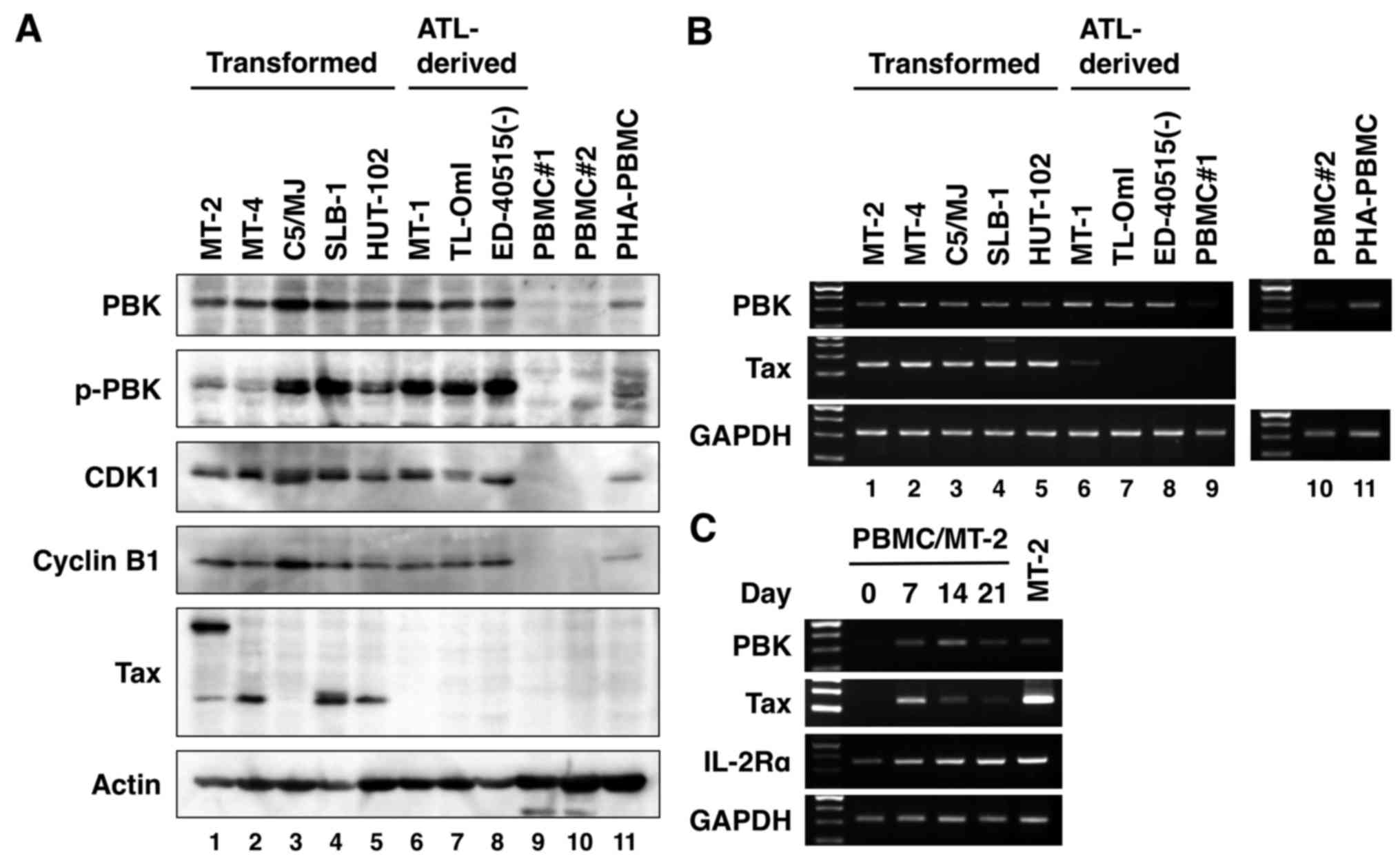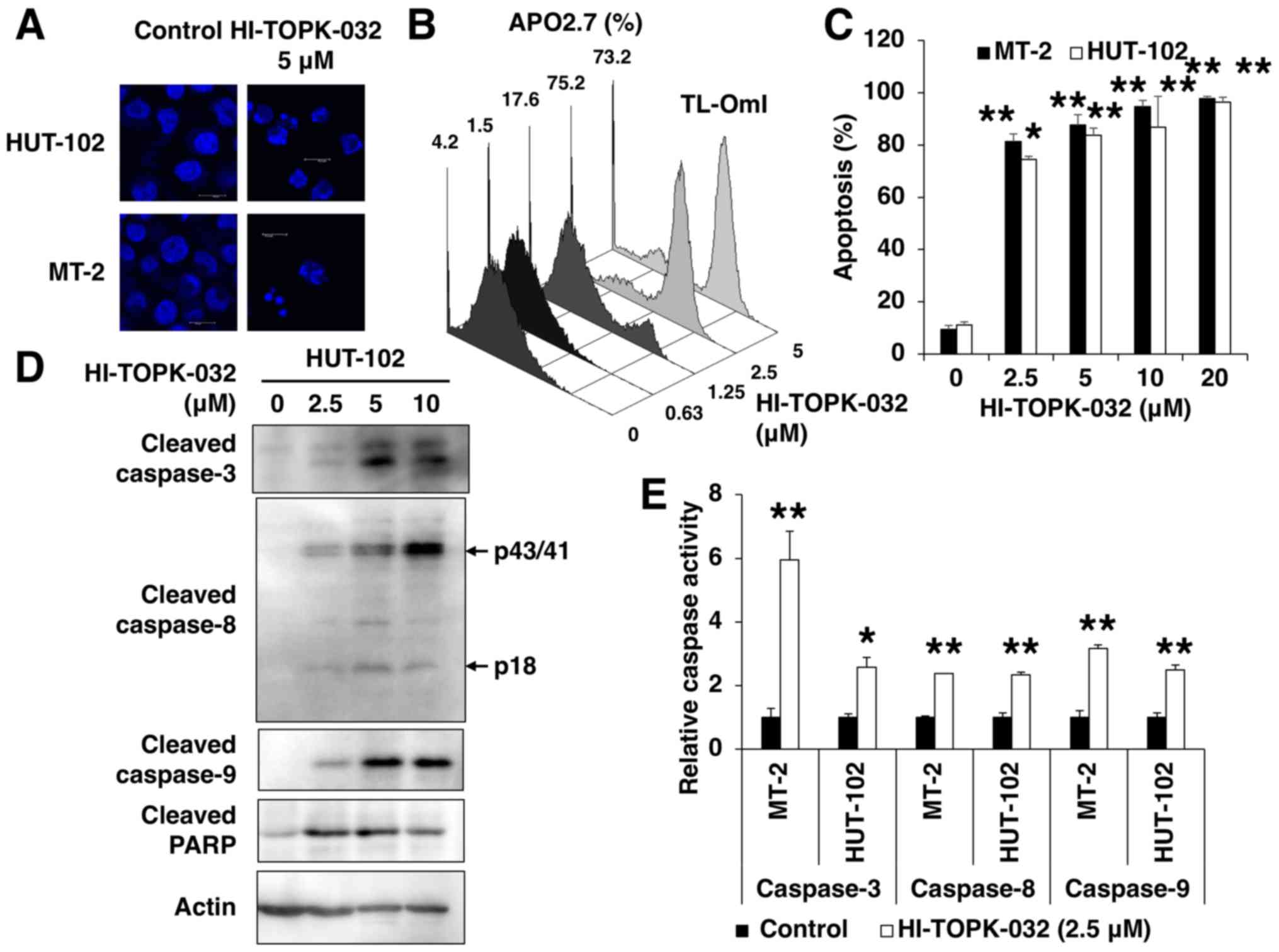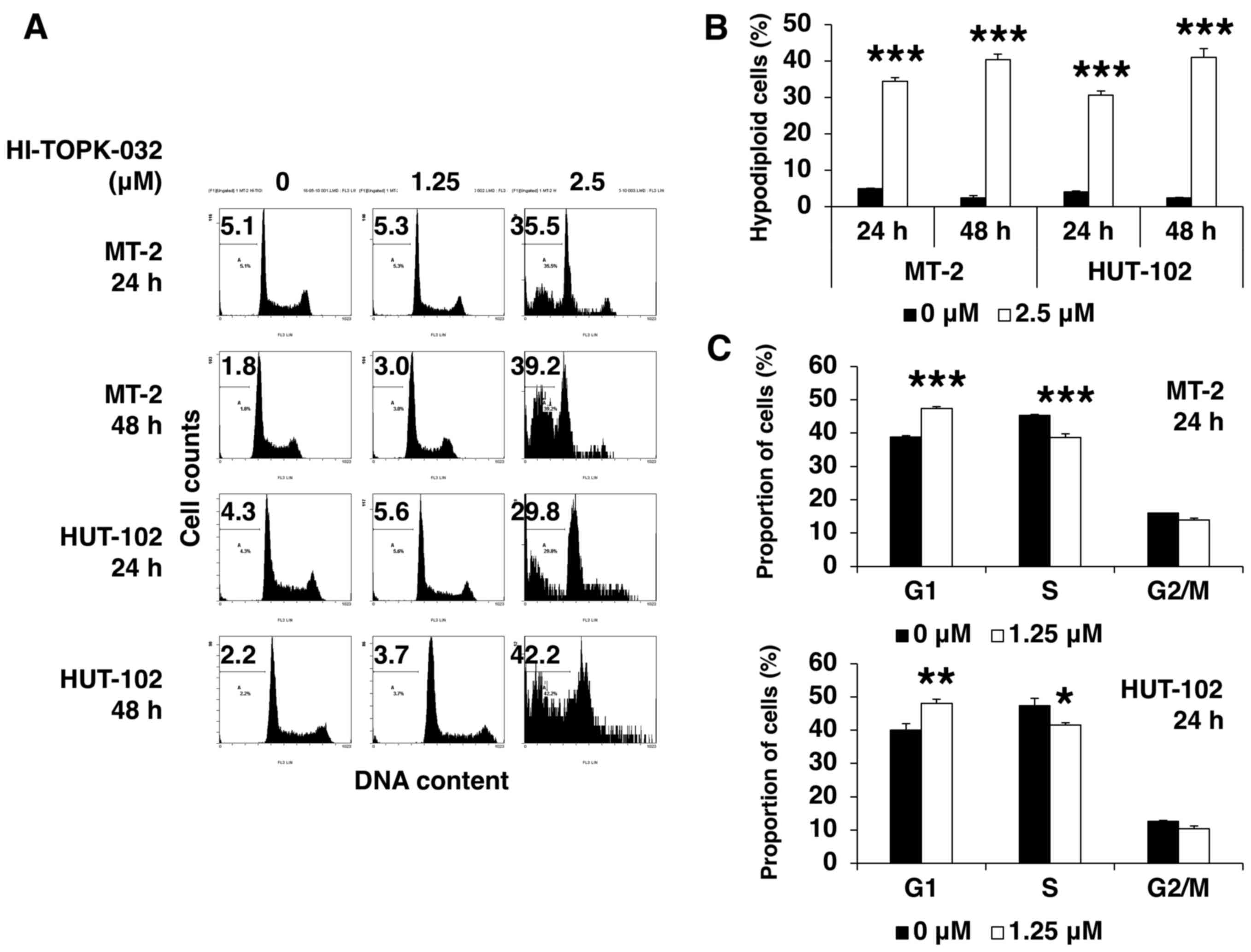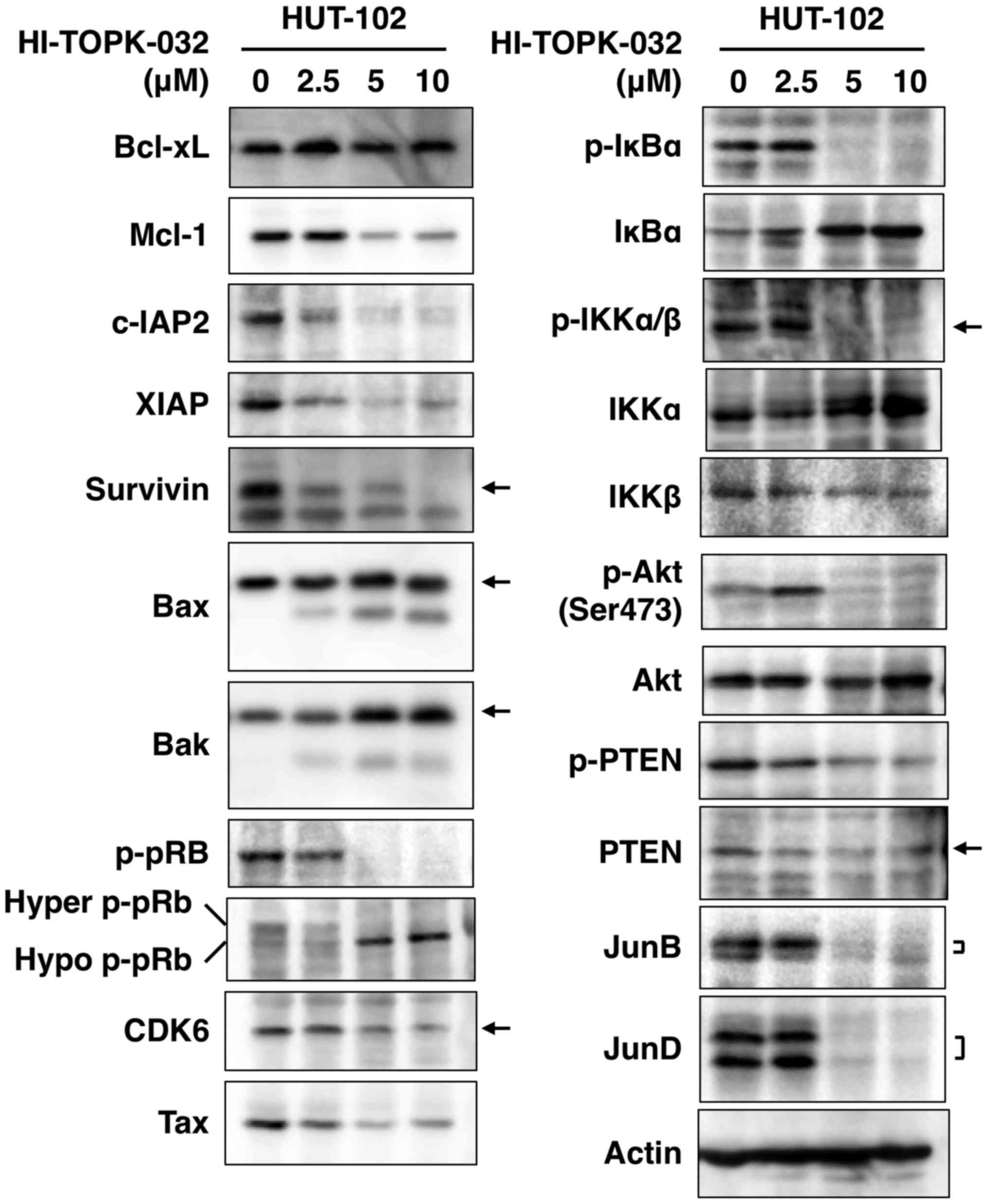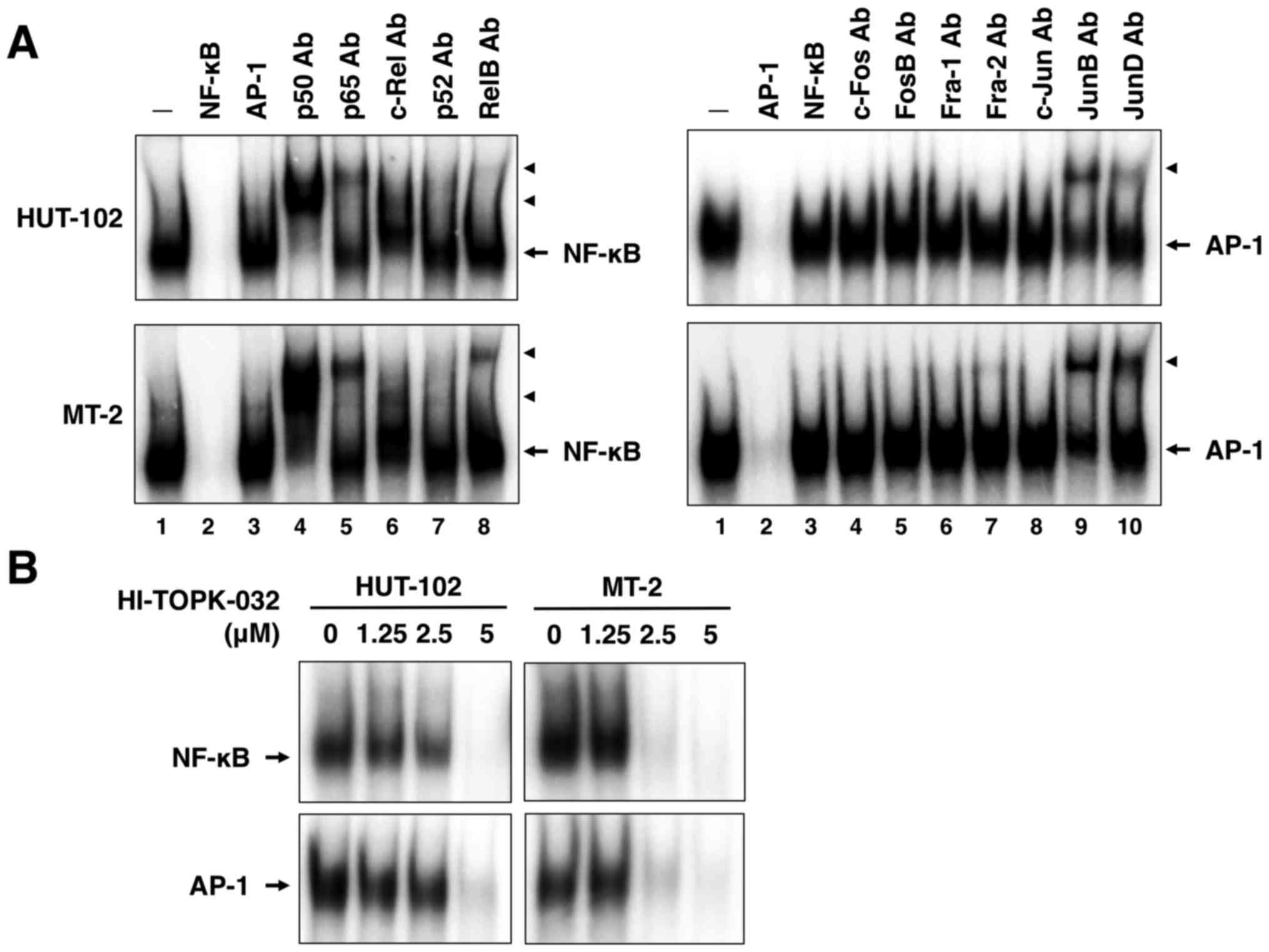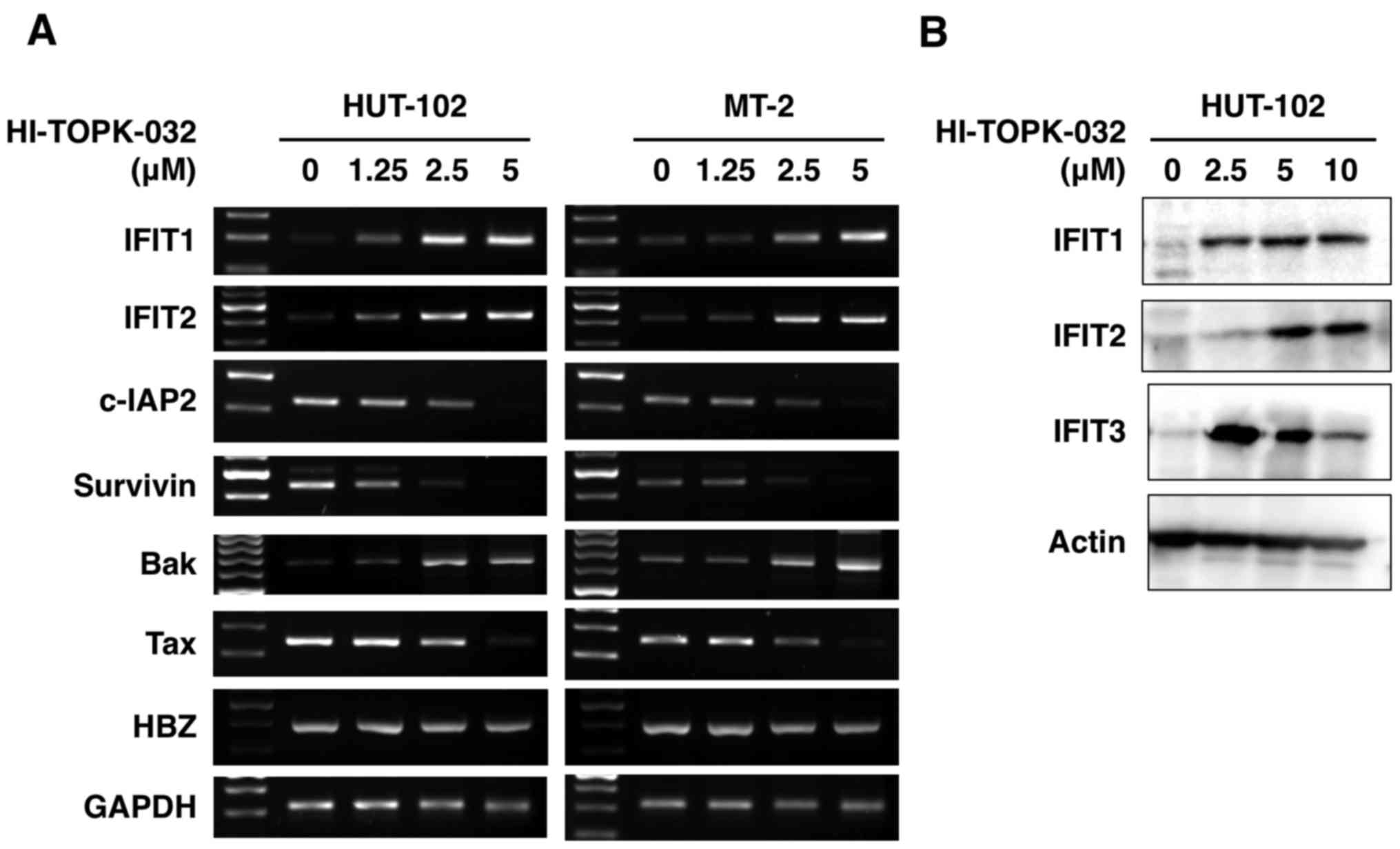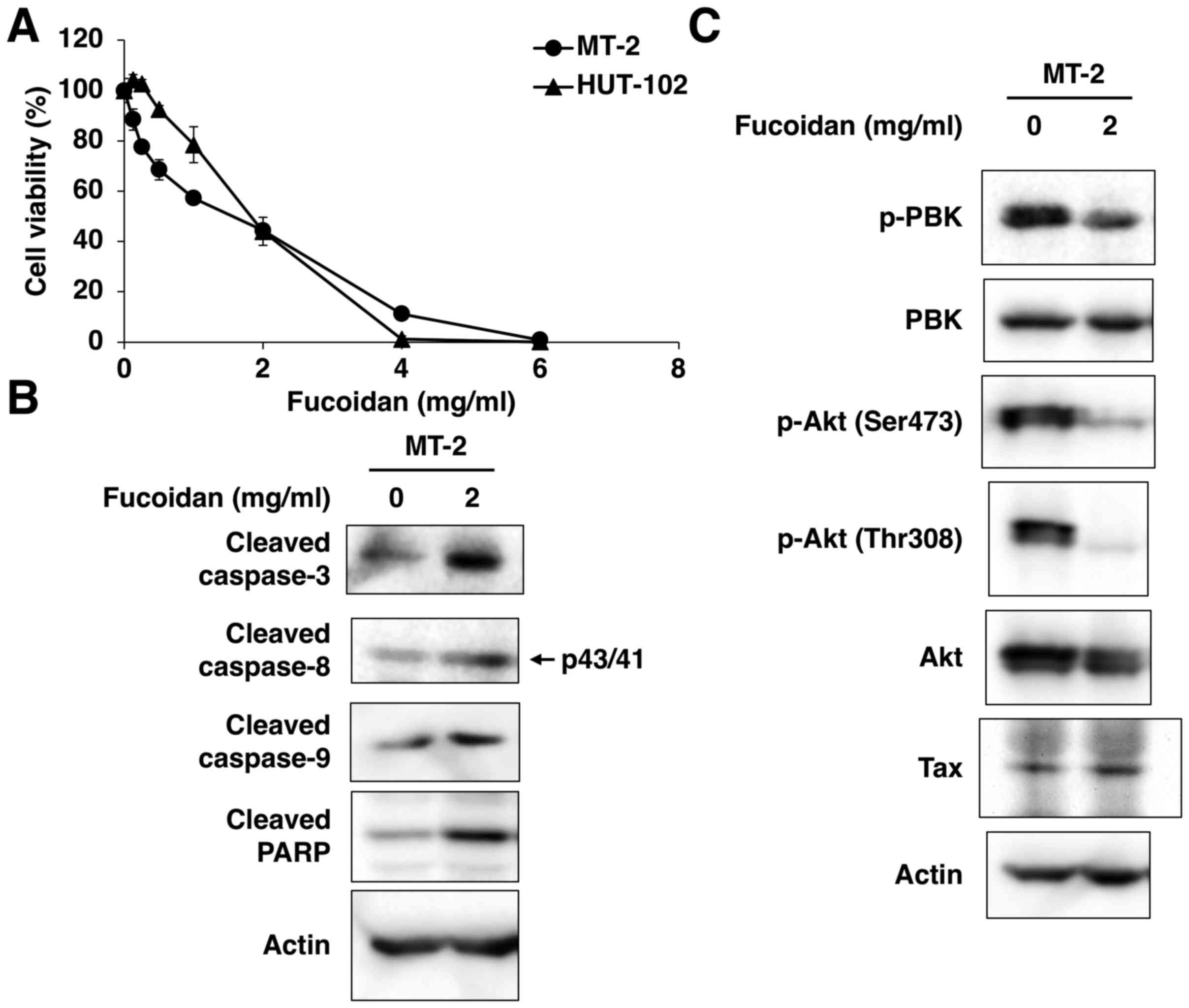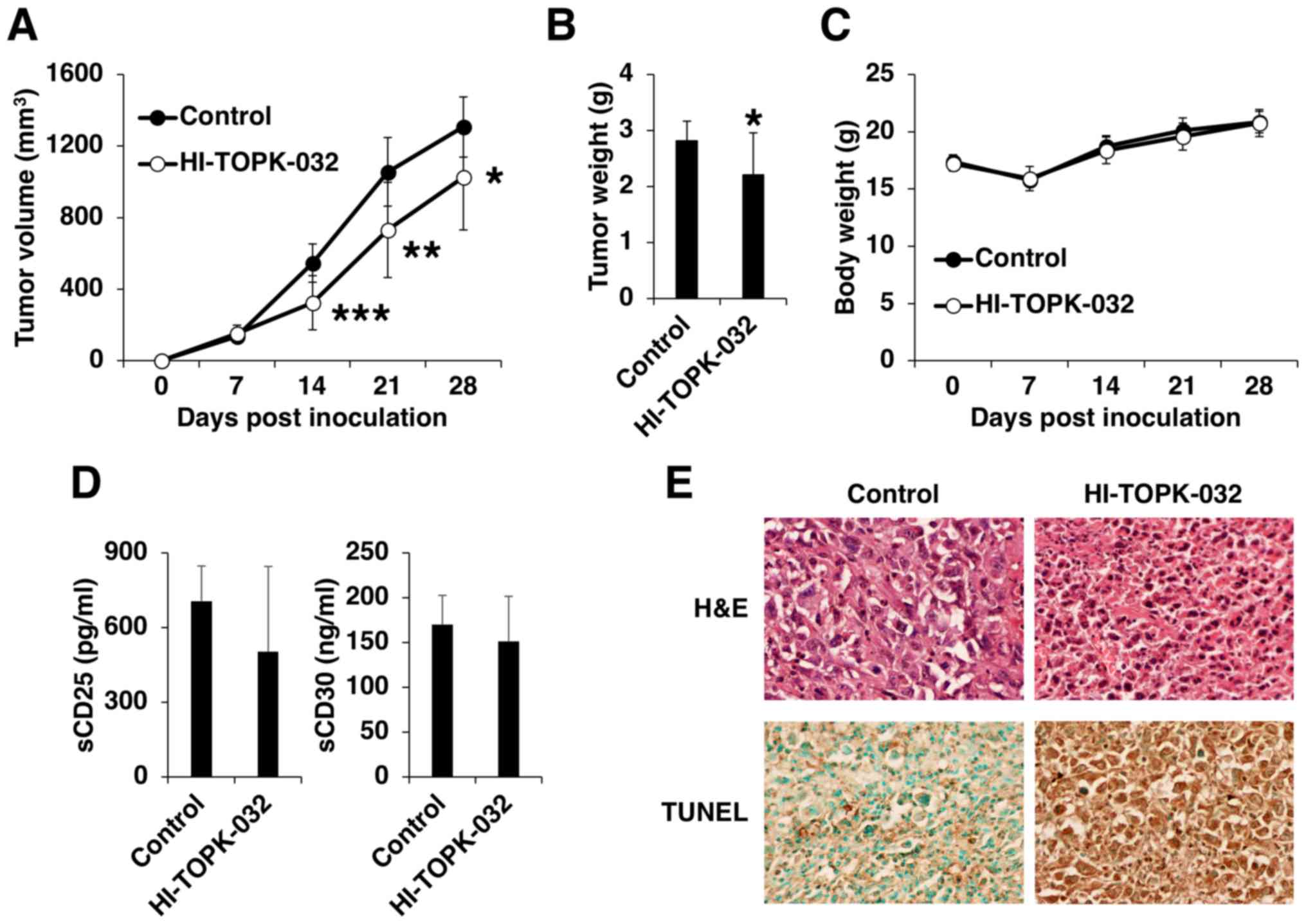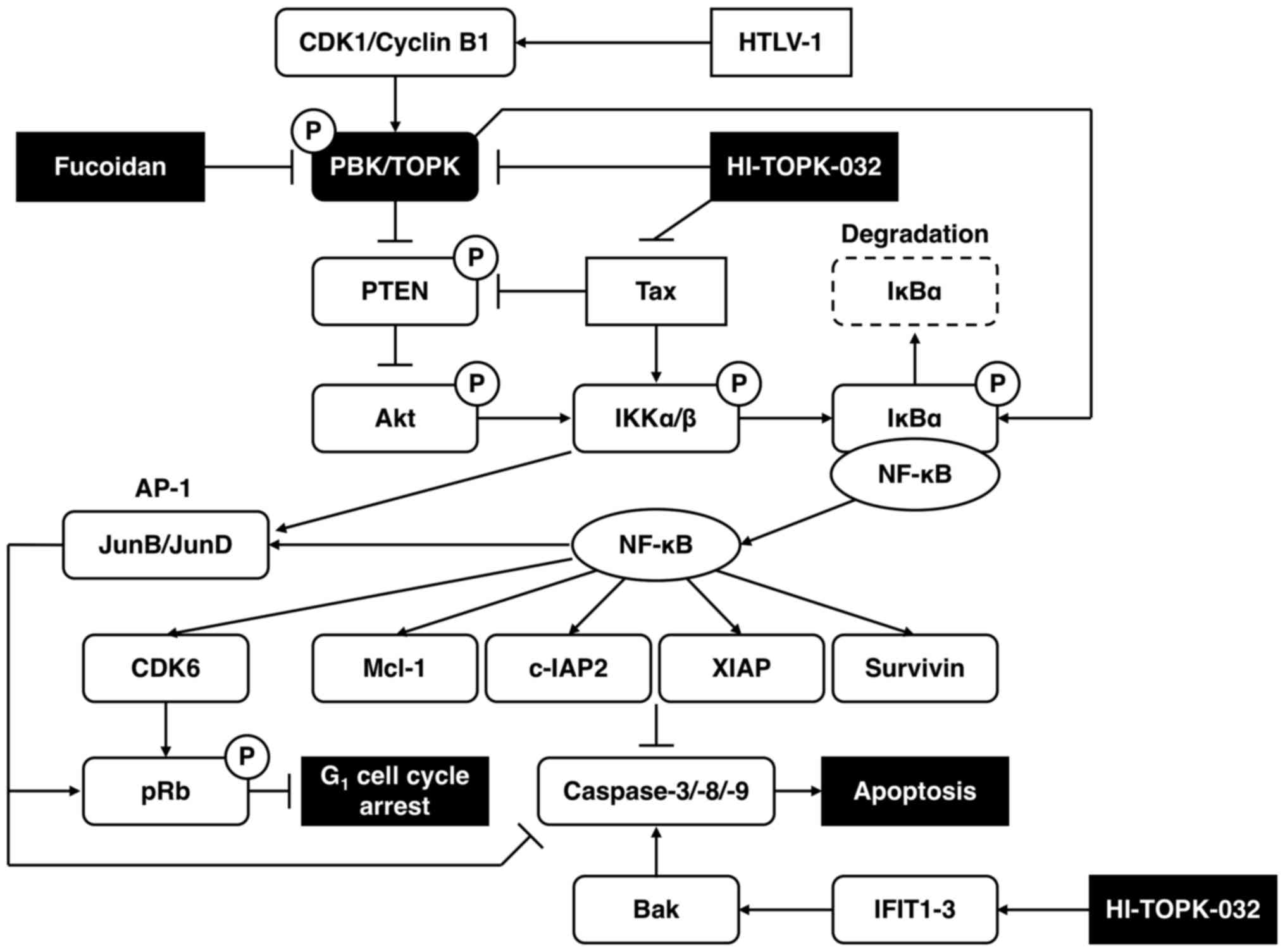|
1
|
Ishitsuka K and Tamura K: Human T-cell
leukaemia virus type I and adult T-cell leukaemia-lymphoma. Lancet
Oncol. 15:e517–e526. 2014. View Article : Google Scholar : PubMed/NCBI
|
|
2
|
Hall WW and Fujii M: Deregulation of
cell-signaling pathways in HTLV-1 infection. Oncogene.
24:5965–5975. 2005. View Article : Google Scholar : PubMed/NCBI
|
|
3
|
Mori N: Cell signaling modifiers for
molecular targeted therapy in ATLL. Front Biosci. 14:1479–1489.
2009. View Article : Google Scholar
|
|
4
|
Watanabe T: Adult T-cell leukemia:
Molecular basis for clonal expansion and transformation of
HTLV-1-infected T cells. Blood. 129:1071–1081. 2017. View Article : Google Scholar : PubMed/NCBI
|
|
5
|
Currer R, Van Duyne R, Jaworski E, Guendel
I, Sampey G, Das R, Narayanan A and Kashanchi F: HTLV tax: A
fascinating multifunctional co-regulator of viral and cellular
pathways. Front Microbiol. 3:4062012. View Article : Google Scholar : PubMed/NCBI
|
|
6
|
Abe Y, Matsumoto S, Kito K and Ueda N:
Cloning and expression of a novel MAPKK-like protein kinase,
lymphokine-activated killer T-cell-originated protein kinase,
specifically expressed in the testis and activated lymphoid cells.
J Biol Chem. 275:21525–21531. 2000. View Article : Google Scholar : PubMed/NCBI
|
|
7
|
Simons-Evelyn M, Bailey-Dell K, Toretsky
JA, Ross DD, Fenton R, Kalvakolanu D and Rapoport AP: PBK/TOPK is a
novel mitotic kinase which is upregulated in Burkitt's lymphoma and
other highly proliferative malignant cells. Blood Cells Mol Dis.
27:825–829. 2001. View Article : Google Scholar
|
|
8
|
Nandi A, Tidwell M, Karp J and Rapoport
AP: Protein expression of PDZ-binding kinase is up-regulated in
hematologic malignancies and strongly down-regulated during
terminal differentiation of HL-60 leukemic cells. Blood Cells Mol
Dis. 32:240–245. 2004. View Article : Google Scholar : PubMed/NCBI
|
|
9
|
Gaudet S, Branton D and Lue RA:
Characterization of PDZ-binding kinase, a mitotic kinase. Proc Natl
Acad Sci USA. 97:5167–5172. 2000. View Article : Google Scholar : PubMed/NCBI
|
|
10
|
Matsumoto S, Abe Y, Fujibuchi T, Takeuchi
T, Kito K, Ueda N, Shigemoto K and Gyo K: Characterization of a
MAPKK-like protein kinase TOPK. Biochem Biophys Res Commun.
325:997–1004. 2004. View Article : Google Scholar : PubMed/NCBI
|
|
11
|
Shats I, Gatza ML, Chang JT, Mori S, Wang
J, Rich J and Nevins JR: Using a stem cell-based signature to guide
therapeutic selection in cancer. Cancer Res. 71:1772–1780. 2011.
View Article : Google Scholar :
|
|
12
|
Takeda K, Tomimori K, Kimura R, Ishikawa
C, Nowling TK and Mori N: Anti-tumor activity of fucoidan is
mediated by nitric oxide released from macrophages. Int J Oncol.
40:251–260. 2012.
|
|
13
|
Tanaka Y, Yoshida A, Takayama Y, Tsujimoto
H, Tsujimoto A, Hayami M and Tozawa H: Heterogeneity of antigen
molecules recognized by anti-tax1 monoclonal antibody Lt-4 in cell
lines bearing human T cell leukemia virus type I and related
retroviruses. Jpn J Cancer Res. 81:225–231. 1990. View Article : Google Scholar : PubMed/NCBI
|
|
14
|
Kimura R, Senba M, Cutler SJ, Ralph SJ,
Xiao G and Mori N: Human T cell leukemia virus type I tax-induced
IκB-ζ modulates tax-dependent and tax-independent gene expression
in T cells. Neoplasia. 15:1110–1124. 2013. View Article : Google Scholar : PubMed/NCBI
|
|
15
|
Mori N and Prager D: Transactivation of
the interleukin-1alpha promoter by human T-cell leukemia virus type
I and type II Tax proteins. Blood. 87:3410–3417. 1996.PubMed/NCBI
|
|
16
|
Inoue J, Seiki M, Taniguchi T, Tsuru S and
Yoshida M: Induction of interleukin 2 receptor gene expression by
p40x encoded by human T-cell leukemia virus type 1. EMBO J.
5:2883–2888. 1986.PubMed/NCBI
|
|
17
|
Kim DJ, Li Y, Reddy K, Lee M-H, Kim MO,
Cho Y-Y, Lee S-Y, Kim J-E, Bode AM and Dong Z: Novel TOPK inhibitor
HI-TOPK-032 effectively suppresses colon cancer growth. Cancer Res.
72:3060–3068. 2012. View Article : Google Scholar : PubMed/NCBI
|
|
18
|
Zhang C, Ao Z, Seth A and Schlossman SF: A
mitochondrial membrane protein defined by a novel monoclonal
antibody is preferentially detected in apoptotic cells. J Immunol.
157:3980–3987. 1996.PubMed/NCBI
|
|
19
|
Iwanaga R, Ozono E, Fujisawa J, Ikeda MA,
Okamura N, Huang Y and Ohtani K: Activation of the cyclin D2 and
cdk6 genes through NF-kappaB is critical for cell-cycle progression
induced by HTLV-I Tax. Oncogene. 27:5635–5642. 2008. View Article : Google Scholar : PubMed/NCBI
|
|
20
|
Kawakami H, Tomita M, Matsuda T, Ohta T,
Tanaka Y, Fujii M, Hatano M, Tokuhisa T and Mori N: Transcriptional
activation of survivin through the NF-kappaB pathway by human
T-cell leukemia virus type I tax. Int J Cancer. 115:967–974. 2005.
View Article : Google Scholar : PubMed/NCBI
|
|
21
|
Kawakami A, Nakashima T, Sakai H, Urayama
S, Yamasaki S, Hida A, Tsuboi M, Nakamura H, Ida H, Migita K, et
al: Inhibition of caspase cascade by HTLV-I tax through induction
of NF-kappaB nuclear translocation. Blood. 94:3847–3854.
1999.PubMed/NCBI
|
|
22
|
Wäldele K, Silbermann K, Schneider G,
Ruckes T, Cullen BR and Grassmann R: Requirement of the human
T-cell leukemia virus (HTLV-1) tax-stimulated HIAP-1 gene for the
survival of transformed lymphocytes. Blood. 107:4491–4499. 2006.
View Article : Google Scholar : PubMed/NCBI
|
|
23
|
Reuter S, Prasad S, Phromnoi K, Ravindran
J, Sung B, Yadav VR, Kannappan R, Chaturvedi MM and Aggarwal BB:
Thiocolchicoside exhibits anticancer effects through
down-regulation of NF-κB pathway and its regulated gene products
linked to inflammation and cancer. Cancer Prev Res (Phila).
3:1462–1472. 2010. View Article : Google Scholar
|
|
24
|
Sun S-C and Cesarman E: NF-κB as a target
for oncogenic viruses. Curr Top Microbiol Immunol. 349:197–244.
2011.
|
|
25
|
Park J-H, Yoon D-S, Choi H-J, Hahm D-H and
Oh S-M: Phosphorylation of IκBα at serine 32 by
T-lymphokine-activated killer cell-originated protein kinase is
essential for chemoresistance against doxorubicin in cervical
cancer cells. J Biol Chem. 288:3585–3593. 2013. View Article : Google Scholar
|
|
26
|
Madrid LV, Mayo MW, Reuther JY and Baldwin
AS Jr: Akt stimulates the transactivation potential of the RelA/p65
subunit of NF-kappa B through utilization of the Ikappa B kinase
and activation of the mitogen-activated protein kinase p38. J Biol
Chem. 276:18934–18940. 2001. View Article : Google Scholar : PubMed/NCBI
|
|
27
|
Hollander MC, Blumenthal GM and Dennis PA:
PTEN loss in the continuum of common cancers, rare syndromes and
mouse models. Nat Rev Cancer. 11:289–301. 2011. View Article : Google Scholar : PubMed/NCBI
|
|
28
|
Nakahata S, Ichikawa T, Maneesaay P, Saito
Y, Nagai K, Tamura T, Manachai N, Yamakawa N, Hamasaki M,
Kitabayashi I, et al: Loss of NDRG2 expression activates PI3K-AKT
signalling via PTEN phosphorylation in ATLL and other cancers. Nat
Commun. 5:33932014. View Article : Google Scholar : PubMed/NCBI
|
|
29
|
Rahdar M, Inoue T, Meyer T, Zhang J,
Vazquez F and Devreotes PN: A phosphorylation-dependent
intramolecular interaction regulates the membrane association and
activity of the tumor suppressor PTEN. Proc Natl Acad Sci USA.
106:480–485. 2009. View Article : Google Scholar :
|
|
30
|
Shinde SR, Gangula NR, Kavela S, Pandey V
and Maddika S: TOPK and PTEN participate in CHFR mediated mitotic
checkpoint. Cell Signal. 25:2511–2517. 2013. View Article : Google Scholar : PubMed/NCBI
|
|
31
|
Cherian MA, Baydoun HH, Al-Saleem J,
Shkriabai N, Kvaratskhelia M, Green P and Ratner L: Akt pathway
activation by human T-cell leukemia virus type 1 Tax oncoprotein. J
Biol Chem. 290:26270–26281. 2015. View Article : Google Scholar : PubMed/NCBI
|
|
32
|
Zhang J-F, Chen Y, Lin G-S, Zhang J-D,
Tang W-L, Huang J-H, Chen J-S, Wang X-F and Lin Z-X: High IFIT1
expression predicts improved clinical outcome, and IFIT1 along with
MGMT more accurately predicts prognosis in newly diagnosed
glioblastoma. Hum Pathol. 52:136–144. 2016. View Article : Google Scholar : PubMed/NCBI
|
|
33
|
Reich NC: A death-promoting role for
ISG54/IFIT2. J Interferon Cytokine Res. 33:199–205. 2013.
View Article : Google Scholar : PubMed/NCBI
|
|
34
|
Yang Y, Zhou Y, Hou J, Bai C, Li Z, Fan J,
Ng IOL, Zhou W, Sun H, Dong Q, et al: Hepatic IFIT3 predicts
interferon-α therapeutic response in patients of hepatocellular
carcinoma. Hepatology. 66:152–166. 2017. View Article : Google Scholar : PubMed/NCBI
|
|
35
|
Matsuoka M and Green PL: The HBZ gene, a
key player in HTLV-1 pathogenesis. Retrovirology. 6:712009.
View Article : Google Scholar : PubMed/NCBI
|
|
36
|
Haneji K, Matsuda T, Tomita M, Kawakami H,
Ohshiro K, Uchihara JN, Masuda M, Takasu N, Tanaka Y, Ohta T, et
al: Fucoidan extracted from Cladosiphon okamuranus Tokida induces
apoptosis of human T-cell leukemia virus type 1-infected T-cell
lines and primary adult T-cell leukemia cells. Nutr Cancer.
52:189–201. 2005. View Article : Google Scholar : PubMed/NCBI
|
|
37
|
Vishchuk OS, Sun H, Wang Z, Ermakova SP,
Xiao J, Lu T, Xue P, Zvyagintseva TN, Xiong H, Shao C, et al:
PDZ-binding kinase/T-LAK cell-originated protein kinase is a target
of the fucoidan from brown alga Fucus evanescens in the prevention
of EGF-induced neoplastic cell transformation and colon cancer
growth. Oncotarget. 7:18763–18773. 2016. View Article : Google Scholar : PubMed/NCBI
|
|
38
|
Kamihira S, Atogami S, Sohda H, Momita S,
Yamada Y and Tomonaga M: Significance of soluble interleukin-2
receptor levels for evaluation of the progression of adult T-cell
leukemia. Cancer. 73:2753–2758. 1994. View Article : Google Scholar : PubMed/NCBI
|
|
39
|
Nishioka C, Takemoto S, Kataoka S,
Yamanaka S, Moriki T, Shoda M, Watanabe T and Taguchi H: Serum
level of soluble CD30 correlates with the aggressiveness of adult
T-cell leukemia/lymphoma. Cancer Sci. 96:810–815. 2005. View Article : Google Scholar : PubMed/NCBI
|
|
40
|
Tanaka H, Fujita N and Tsuruo T:
3-Phosphoinositide-dependent protein kinase-1-mediated IkappaB
kinase beta (IkkB) phos-phorylation activates NF-kappaB signaling.
J Biol Chem. 280:40965–40973. 2005. View Article : Google Scholar : PubMed/NCBI
|
|
41
|
Ozes ON, Mayo LD, Gustin JA, Pfeffer SR,
Pfeffer LM and Donner DB: NF-kappaB activation by tumour necrosis
factor requires the Akt serine-threonine kinase. Nature. 401:82–85.
1999. View Article : Google Scholar : PubMed/NCBI
|
|
42
|
Dan HC, Cooper MJ, Cogswell PC, Duncan JA,
Ting JP-Y and Baldwin AS: Akt-dependent regulation of NF-{kappa}B
is controlled by mTOR and Raptor in association with IKK. Genes
Dev. 22:1490–1500. 2008. View Article : Google Scholar : PubMed/NCBI
|
|
43
|
Cahill CM and Rogers JT: Interleukin (IL)
1beta induction of IL-6 is mediated by a novel phosphatidylinositol
3-kinase-dependent AKT/IkappaB kinase alpha pathway targeting
activator protein-1. J Biol Chem. 283:25900–25912. 2008. View Article : Google Scholar : PubMed/NCBI
|
|
44
|
Brown RT, Ades IZ and Nordan RP: An acute
phase response factor/NF-kappa B site downstream of the junB gene
that mediates responsiveness to interleukin-6 in a murine
plasmacytoma. J Biol Chem. 270:31129–31135. 1995. View Article : Google Scholar : PubMed/NCBI
|
|
45
|
Garg AD and Agostinis P: Cell death and
immunity in cancer: From danger signals to mimicry of pathogen
defense responses. Immunol Rev. 280:126–148. 2017. View Article : Google Scholar : PubMed/NCBI
|



